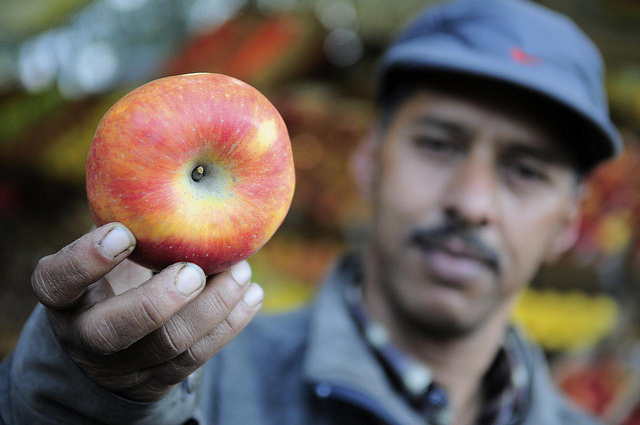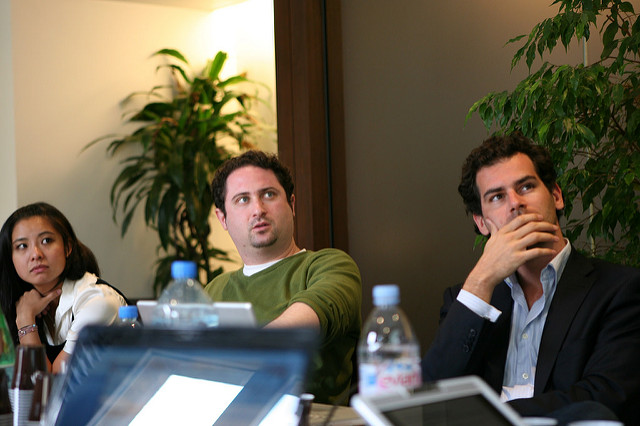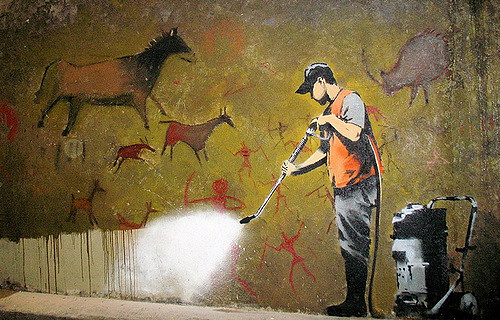Unlock the Magic in Your Story Now
Get the Free 20 questions to Ask Before Launching Your Idea workbook when you sign up for occasional updates.
Get the Free 20 questions to Ask Before Launching Your Idea workbook when you sign up for occasional updates.
Articles filed in: Strategy
Acts Of Differentiation
 One reason we market to customers, beyond our desire to create brand awareness, is to communicate how and why our products are different and better than those of the competition. Of course, how products are created and experiences are designed can be differentiators. But we sometimes overlook opportunities to differentiate and add value—especially when it comes to our marketing tactics.
One reason we market to customers, beyond our desire to create brand awareness, is to communicate how and why our products are different and better than those of the competition. Of course, how products are created and experiences are designed can be differentiators. But we sometimes overlook opportunities to differentiate and add value—especially when it comes to our marketing tactics.
At the food market, fruit vendors vie for the attention of passers-by. The tactic adopted by most is to discount and holler. The people who use this tactic change their pitch according to the time of day or how much stock is left, so that it appeals to whatever the bargain hunter seems to be looking for. The result feels like an inconsistent, erratic, emergency (which no doubt it often is).
Contrast that with the trader who shows up with a small range of quality, seasonal produce. There is no discounting, shouting or touting at his stall. His patient, predictable, consistent approach means the same people return each week. Some send their friends, and so his loyal customer base grows over time—no hollering required. His marketing strategy is an intentional act of differentiation.
Our marketing can be as deliberate, differentiated and aligned with our values as the products we choose to make, serve and sell.
Image by CIAT.
A Common Sense Approach To Customer Insights
filed in Innovation, Marketing, Strategy
 Joanne is a small business owner. She operates a catering van that travels to local industrial estates, serving workers who don’t have easy access to high street cafes and fast food restaurants closer to town. Joanne’s business lives and dies on what she knows about her customers. So she makes it her business to know a lot about them.
Joanne is a small business owner. She operates a catering van that travels to local industrial estates, serving workers who don’t have easy access to high street cafes and fast food restaurants closer to town. Joanne’s business lives and dies on what she knows about her customers. So she makes it her business to know a lot about them.
She knows that Darren leaves home without breakfast before his kids are up. There is no time to pack lunch because he has to be on the road before rush hour traffic hits. Joanne knows that most days Darren stops at the convenience store for a Red Bull which he drinks in his truck before beginning a day of sawing, sanding and heavy lifting. Unlike the office workers in the city who work from 9-5 and lunch at midday, Darren will be famished by 10–which is why her van makes its rounds before 11. She knows he needs something he can eat with one hand while standing in his workshop between jobs, and that he won’t be looking for sushi or a paleo salad bowl. Joanne knows that Darren will knock off early on Friday and head to the pub for a few beers with his mates. He will do the garden on Saturday and take his boys to footie on Sunday.
These insights are invaluable to Joanne’s business. They influence her hours of operation, the products she stocks and the customer experience she provides. And she didn’t need a data analyst or an algorithm to uncover them.
We can learn as much from spending time with our customers as we can by looking for clues among surveys, demographics and data sets. It turns out that understanding comes from looking beyond data points that can be easily measured or plotted on a graph. How much do you know about how your customers behave or what they think about, prioritise, value and believe in?
Image by Michelle Ress.
When To Fall In Love With Your Idea
filed in Innovation, Strategy
 Every business is founded on an assumption. We see a problem and propose a solution (maybe a new product or service), that we assume will be embraced with open arms. Before long we’ve fallen headlong for our idea, often without challenging our assumptions.
Every business is founded on an assumption. We see a problem and propose a solution (maybe a new product or service), that we assume will be embraced with open arms. Before long we’ve fallen headlong for our idea, often without challenging our assumptions.
Even with all the data in the world, it’s not possible to know for sure how the people we hope to serve will respond until we give them the opportunity to do just that. When we skip this step, we get caught in the trap of trying to show people why they can’t live without the thing we created. Our ideas succeed when we do exactly the opposite.
Don’t fall in love with your idea without first giving those who will adopt it a chance to show you why it’s one worth pursuing.
Image by Kat.
Success Is…
 Not surprisingly there’s been a lot of talk in the news lately about winning. It’s a subject that’s never far from our minds, especially if we’re leading or building a business. Conventional wisdom dictates that someone has to come out on top, and if we believe this is true we want it to be us and not the other guy. We don’t want to be caught short, overtaken or left behind—so we allocate resources (both material and emotional) to make sure we win. Sometimes we do this without articulating why winning is important and what it looks like. We seldom calculate what the real cost of pursuing a win above all else will be—not just on our balance sheets, but to our values, reputations, legacies, and well-being beforehand.
Not surprisingly there’s been a lot of talk in the news lately about winning. It’s a subject that’s never far from our minds, especially if we’re leading or building a business. Conventional wisdom dictates that someone has to come out on top, and if we believe this is true we want it to be us and not the other guy. We don’t want to be caught short, overtaken or left behind—so we allocate resources (both material and emotional) to make sure we win. Sometimes we do this without articulating why winning is important and what it looks like. We seldom calculate what the real cost of pursuing a win above all else will be—not just on our balance sheets, but to our values, reputations, legacies, and well-being beforehand.
If we play to win is our goal to make sure that others lose, or is it something bigger? When we forsake traditionally, narrow metrics of success—things that can easily be weighed, measured and carefully graphed, we are free to embrace a much broader definition.
As business leaders, entrepreneurs and creators, we have a choice to make. We can aim to dominate and defeat, or we can choose to build and serve.
You might remember the 70s comic strip ‘love is…’ by Kim Casali. Even as a young child, long before boyfriends and broken hearts, I adored that comic strip. It showed me that there was no one way to define love—that there was more to it than a single long-stemmed red rose version of the truth. It taught me that we each get to choose what’s important and what’s worth working towards.
The same goes for success. We get to choose how to contribute and serve, how to achieve and lead.
Winning means different things to different people. It pays to be clear about exactly what your (and your team’s) definition of success is, and to know what you’re prepared to do to achieve your goals. Because unlike loving, winning for winning’s sake is overrated.
Image by Simon.
The Power Of A Value Strategy
 The city centre 7-Eleven fulfils the need of a particular customer. It’s a place for the every day, unplanned or forgotten last-minute purchases, where the worker returning home from late shift might grab headache tablets or a pint of milk. Convenience stores are not trying to deliver a premium customer experience. The business is designed to provide value by taking into account the context in which the customer will use its services. If accessibility and convenience are the pillars of the value strategy, then every business decision the company makes is filtered through that lens.
The city centre 7-Eleven fulfils the need of a particular customer. It’s a place for the every day, unplanned or forgotten last-minute purchases, where the worker returning home from late shift might grab headache tablets or a pint of milk. Convenience stores are not trying to deliver a premium customer experience. The business is designed to provide value by taking into account the context in which the customer will use its services. If accessibility and convenience are the pillars of the value strategy, then every business decision the company makes is filtered through that lens.
When a manager questions if stores should stock teddy bears or expensive perfume the answer is obvious. Everything the business does must align with the customer’s perception of the part it plays in his life.
It’s only when we are clear about how we best fulfil our customers’ needs that we can tell a story that resonates with them. In a world of the shiny, new next thing the power of consistently delivering on customers’ expectations is underrated.
Image by rpavich.
The Upside Of Ignoring Your Competition
 In his memoir Bryan Cranston (the actor who plays Walter White in the cult drama series Breaking Bad), describes a mental shift he made about auditions twenty years ago. He and the other actors would smile politely at each other while they sweated it out waiting for their turn to audition. Every person in the room was attached to the outcome. They were all there competing to get something.
In his memoir Bryan Cranston (the actor who plays Walter White in the cult drama series Breaking Bad), describes a mental shift he made about auditions twenty years ago. He and the other actors would smile politely at each other while they sweated it out waiting for their turn to audition. Every person in the room was attached to the outcome. They were all there competing to get something.
Everything changed when Bryan began to focus on the process instead of the outcome. When he stopped thinking of his audition as a means to an end and became less invested in the outcome, he was free to enjoy and serve the work.
“I wasn’t going to the audition to get anything: a job or money or validation. I wasn’t going to compete with the other guys. I was going to give something.”
This new mindset meant Bryan freed himself up to give his best.
Whenever we’re trying to succeed at anything—going for a promotion, getting funding or closing the sale, we become attached to the outcome. That focus on a future we can’t control stops us fulfilling our potential in the moment.
We don’t win by trying to beat our competition. We triumph and thrive when we are motivated to do our best work, irrespective of what the competition is doing.
Image by Raphaël Labbé.
Lucky To Have You
filed in Storytelling, Strategy
 The customers at Estabar are lucky to have Bec and her team creating a welcoming space where they serve the best food, gelato and coffee in Newcastle with love and care.
The customers at Estabar are lucky to have Bec and her team creating a welcoming space where they serve the best food, gelato and coffee in Newcastle with love and care.
Why are your customers lucky to have you?
You probably haven’t asked yourself this question in a while.
This is your invitation to do just that. If you’d like to share your reasons pop over to my Facebook page, (yes I finally have a home there) and add them in the comments.
It’s only when you know and embrace what you’re doing well that you can do more of it.
Why We Need Brand Stories
filed in Storytelling, Strategy
 Anthropologists tell us story is the universal language that has quite literally ensured the survival of the human race. Our Neanderthal ancestors told stories to pass on information that would keep the tribe safe—tales of misadventure and survival about what to fear or to embrace. We tell stories to inform and connect, to inspire and create change.
Anthropologists tell us story is the universal language that has quite literally ensured the survival of the human race. Our Neanderthal ancestors told stories to pass on information that would keep the tribe safe—tales of misadventure and survival about what to fear or to embrace. We tell stories to inform and connect, to inspire and create change.
Brands have long known that story is a powerful tool, but in business circles, we’re often more concerned with the mechanics of storytelling than the reasons we need a story to tell. Where would we be today if our ancestors had started with the mechanics without understanding why their stories mattered? Even the most primitive humans understood that their stories had a purpose.
Over the past fifty years, the outward motivation of brand storytelling (in the form of advertising) was to get attention in the moment and to acquire more customers. In many ways the ‘tell to sell’ strategy sold the power of storytelling short. Today the businesses that use story to the best advantage understand the primary reason to invest in brand storytelling is to build trust with the customers we are committed to serving and keeping, and we can’t begin to tell effective stories without understanding the trust gap we’re trying to fill.
Trust is the most undervalued and precious resource of our time. This makes storytelling one of the most important investments we can make.
Image by Dominique.
Creating A Sustainable Advantage
filed in Storytelling, Strategy
 The two bookstores on Bourke Street have very different layouts, but they mostly stock similar titles. The three nearby cafes all serve eggs, porridge or toast for breakfast. Both convenience stores along the street stock the same brands of chocolate, snacks and emergency litres of milk. And the websites that promote them were each built using identical lines of code.
The two bookstores on Bourke Street have very different layouts, but they mostly stock similar titles. The three nearby cafes all serve eggs, porridge or toast for breakfast. Both convenience stores along the street stock the same brands of chocolate, snacks and emergency litres of milk. And the websites that promote them were each built using identical lines of code.
When most businesses with access to similar resources are creating comparable products and services where does our sustainable advantage lie? Time and again we see that tangible advantages like location, quality and price aren’t enough to keep customers engaged and loyal.
The businesses that not only survive, but thrive are the ones that do what their competitors don’t do, not what their competitors can’t do. Often this is the human work of empathising, connecting and creating intangible value that’s not always seen but it’s certainly felt.
What do you do that your competitors aren’t prepared to do?
Image by Giovani Racca.
 When we moved house a year ago, we had the bathroom floor tiles professionally cleaned. Exactly one year on I got a message from the company about a special offer. At first glance, I thought this was a helpful reminder and smart marketing on the part of the cleaning company who had anticipated my needs. But my opinion changed when I realised the special offer was for carpet cleaning. We don’t have any carpets in our home.
When we moved house a year ago, we had the bathroom floor tiles professionally cleaned. Exactly one year on I got a message from the company about a special offer. At first glance, I thought this was a helpful reminder and smart marketing on the part of the cleaning company who had anticipated my needs. But my opinion changed when I realised the special offer was for carpet cleaning. We don’t have any carpets in our home.